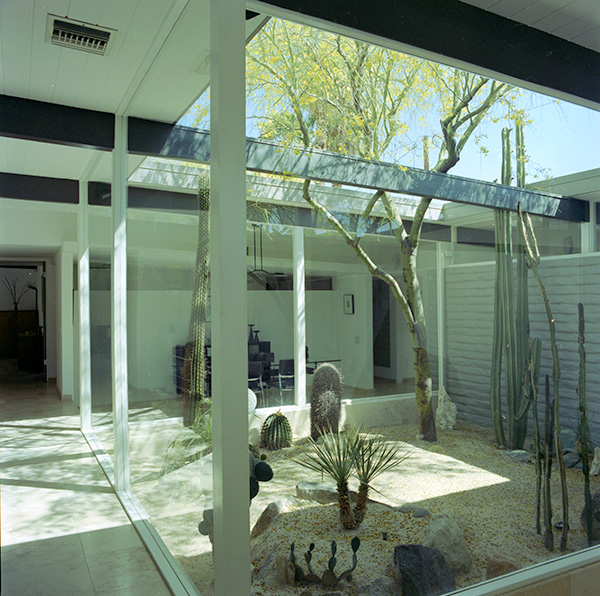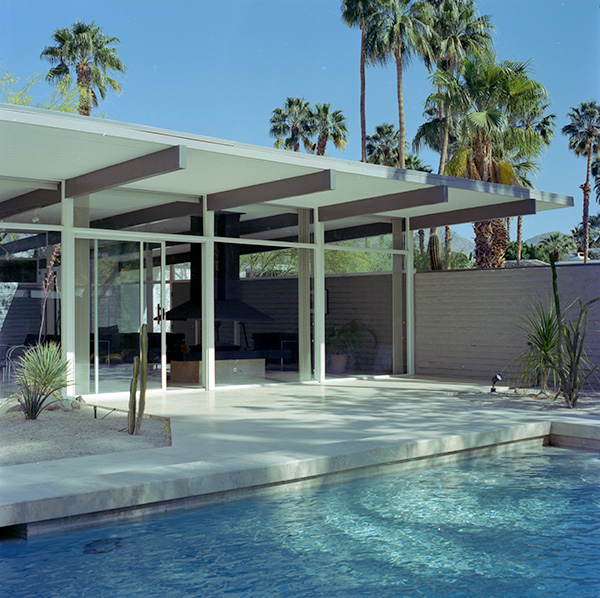Alan Hess. Donald Wexler 1926-2015
|
Wexler & Harrison, Lilliana Gardens House, Palm Springs 1954, ph. Emanuele Piccardo No one realized it at the time, but midcentury Palm Springs was a golden age of modern architecture. Donald Wexler, one of its leading figures, died June 26 at age 89. He and his remarkably talented local colleagues (William Francis Cody, Albert Frey, E. Stewart Williams, Richard Harrison, John Porter Clark, Hugh Kaptur, and others) were committed to modern principles, but each brought originality to their designs. Wexler’s designs were straightforward, clean, never excessive, and turned the essence of their structural systems into elegant, creative buildings. When he moved to Palm Springs in 1951, it was the right place to practice that kind of architecture. He seemed to have a knack for being in the right place at the right time. On a 1950 trip to Los Angeles after graduating from the University of Minnesota School of Architecture, he concocted a way to meet his hero, Richard Neutra: Pretending he wanted a job, he asked for an interview. When Neutra actually offered him a job, his plan to return to Minnesota vanished. The next year he moved to the desert to work for Cody, and in 1953 he and another Cody employee, Richard Harrison, formed their own partnership. Wexler & Harrison, Lilliana Gardens House, Palm Springs 1954, ph. Emanuele Piccardo The desert community turned out to be an ideal place for a young architect: Schools, custom homes, tract homes, stores, civic buildings, country clubs, gas stations, offices, and even airports were in demand. Wexler would get opportunities to design each building type. He remained focused on the fundamental modern ideals that he admired in Neutra: expressing modern materials and structures, as well as creating comfortable spaces that took advantage of indoor-outdoor living. With new schools in demand in the growing area, Wexler noticed a prefabricated steel frame system developed by Calcor Corporation structural engineer Bernard Perlin. Working with Perlin, he and Harrison used it to build a series of school buildings beginning in 1957 that were both more economical than standard construction and stood up to the desert’s extreme climate. Typical of Wexler, the buildings also boasted elegantly proportioned structural members. Wexler & Harrison, Lilliana Gardens House, Palm Springs 1954, ph. Emanuele Piccardo Wexler and Perlin saw even greater possibilities for steel systems applied to housing—something of a Holy Grail that had long captivated modern architects (including Buckminster Fuller, Raphael Soriano, Craig Ellwood, and Wexler’s hero, Neutra). Beginning in 1961, Wexler and Harrison developed the same system into a successful, prefabricated, all-steel mass-produced house for the Alexander Construction Company, a large homebuilder in Palm Springs. The system combined a factory-prefabricated kitchen, a bathroom, and wall units; the walls could be erected on a concrete pad in an eight-hour day. Different steel roof configurations added visual variety. Wexler continued to use the steel system for custom homes, and intriguingly for the prefabricated room units integrated into the 1971 Contemporary Hotel, designed by Welton Becket and Associates, for Walt Disney World. Wexler’s many residential designs ranged from a classic wood post and beam design for his own house that was modular and easily expanded as his family grew, to modern tract homes and even a luxurious steel and adobe block residence for Dinah Shore. After he and partner Richard Harrison parted amicably in 1961, Wexler won the commission for the Palm Springs International Airport over larger and more experienced Los Angeles firms. The two-story entry hall—rotated 45 degrees—and the oblique one-story concourses evoke the swept-back wings of a jet airplane. Outdoor waiting areas gave visitors a taste of the delicious desert air. By orienting the building to the panoramic view of the mountains, the airport was a true gateway to the pleasures of the resort town. With a few forays to Los Angeles and the East Coast, Wexler worked primarily in the Palm Springs area until he retired. During his career he was not nationally known, and never tried to be. When Palm Springs began to be rediscovered for its treasure trove of midcentury modern architecture in the late 1990s, however, he was surprised by the attention he received. Books and magazine articles on Palm Springs architecture always spotlighted his steel houses. In 2004 Wexler became a Fellow of the AIA, and the University of Minnesota gave him their distinguished alumnus award. A film, Journeyman Architect: The Architecture of Donald Wexler, was produced in 2009, and in 2011 the Palm Springs Art Museum mounted Steel and Shade, an exhibit of his work accompanied by a catalog. Local preservationists landmarked many of his buildings; one of the steel houses is listed on the National Register of Historic Places. The 2014 demolition of the Spa Bath House (a Wexler collaboration with William Cody, Richard Harrison, and Philip Koenig), however, was widely mourned. Its delicate colonnade entry of prefabricated concrete-domes, rising from tiled pools, had become the very image of the best of Palm Springs Modernism. This article was published in The Architect’s Newspaper |


